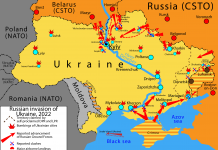
In the aftermath of the Essequibo referendum, Venezuelan President Nicolás Maduro is taking assertive steps to implement the results of the vote, which, despite minimal street turnout, was declared a triumph by the Chavista government with a reported 10.4 million participants. This development has sparked renewed skepticism regarding the integrity of Venezuela’s electoral institutions. Maduro, in a recent televised address, unveiled a revised national map that integrates Essequibo, sidestepping the contentious boundary issue. During this broadcast, he outlined a set of initiatives and forthcoming laws aimed at solidifying Venezuela’s claim over the contested region and its assets. Prior to this, Maduro had dispatched troops to Puerto Barima, situated on Venezuela’s Atlantic frontier, adjacent to the contested zone.
The narrative battle is intensifying. Not long ago, Guyana erected its flag on a modest elevation within Essequibo. Concurrently, on the referendum day, Venezuela’s Ministry of Communication disseminated footage showing Indigenous individuals replacing the Guyanese flag with Venezuela’s. In a strategic move, Maduro has announced legislation to establish a new administrative division within the disputed territory. He has already designated Major-General Alexis Rodríguez Cabello, a PSUV representative, as the interim leader, who will govern from Tumeremo, a mining town in Bolívar state, a mere 100 kilometers from San Martín de Turumbang, located within the area of contention.
“We want the peaceful rescue of the Guayana Esequiba,” said Maduro while adding, “Our Guayana Esequiba has been de facto occupied by the British Empire and its heirs and they have destroyed the area”.
Referencing the PetroCaribe initiative established under Hugo Chávez’s leadership, Venezuela once provided Caricom nations with oil at reduced prices in return for political backing of its Bolivarian revolution. Nonetheless, in the longstanding Essequibo dispute, these nations have historically sided with Guyana.
President Maduro has directed PDVSA, Venezuela’s national oil company, to chart out resource exploration and extraction plans in Essequibo. He has also mandated the National Assembly to formulate legislation that would invalidate any oil concessions made by Guyana within the maritime boundaries yet to be demarcated. Notably, Exxon Mobil, an American corporation, operates an offshore rig in the vicinity. Maduro has issued a three-month ultimatum to entities unlawfully exploiting resources in the area to adhere to Venezuelan law. Furthermore, he has urged the National Assembly to designate environmental conservation zones and national parks within the disputed territory.
The contention over Essequibo can be traced back to 1777 when the Captaincy General of Venezuela depicted the 159,500-square-kilometer region on its national map, despite the absence of Venezuelan occupation during both the Spanish colonial era and post-independence period. In 1899, British Guiana successfully established boundaries at the Paris Arbitral Tribunal, a decision that has since been criticized as biased. Fast forward two centuries, Domingo Hernández Lárez, leader of the National Armed Forces’ Strategic Operational Command, shared images on social media showcasing Venezuelan troops delivering medical services to Indigenous populations in the region. Accompanying these visuals were pictures of construction material-laden trucks, symbolizing Venezuela’s commitment to the comprehensive development of the nation, as they journey “Towards the Guyana Shield.”
“We are very concerned that President Maduro and the government of Venezuela can use their own internal scenario and internal politics to create an instability within our region, to create fear and terror within the hearts and minds of their neighbors,” said Guyanese President Mohamed Irfaan Ali .
Ali emphasized that the two nations are committed to the proceedings of the International Court of Justice, as established by the 1966 Geneva Agreement, which was enacted by the United Nations Secretary-General’s decision following numerous fruitless discussions. This is in spite of Venezuela’s persistent stance that the court lacks the authority to resolve the conflict.
“The international community has a great responsibility to ensure that peace prevails. Many countries are supporting Guyana in a peaceful resolution that must come out of the ICJ process,” the Guyanese president said. “We are working with our partners in the U.S. Departments of State and Defense to ensure that Guyana is not caught off guard and is prepared, and also to act as a country that respects the rule of law and international order.”
Brazil, neighboring both Venezuela and Guyana, has voiced apprehensions regarding the intensifying territorial contention. President Luiz Inácio Lula da Silva engaged in dialogue with leaders Maduro and Ali, subsequently bolstering Brazil’s military presence along its frontier. The Ministry of Defense augmented the forces of the Boa Vista unit in Roraima state, doubling the number of troops from 70 to 130. The unit’s declared objective is the safeguarding of Brazil’s sovereignty, as per the ministry’s proclamation. Following the Venezuelan plebiscite, President Lula authorized the dispatch of approximately 20 armored vehicles to the tri-border area.
“We are following the situation with concern, but I don’t think it’s going to come to that [an armed confrontation],” said Ambassador Gisela Padovan, secretary for Latin America and the Caribbean at the Brazilian Ministry of Foreign Affairs while adding that she trusted Brazilian diplomacy and that of the rest of the neighboring countries will manage to “deflate the process.”





